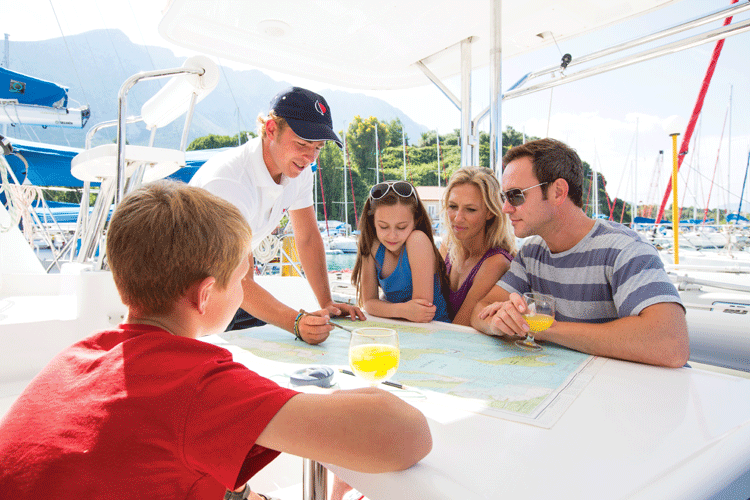Get the Most out of Your Charter Sailing Experience with These 5 Questions
The two most important things before leaving the charter base dock are the technical checkout and the chart briefing. I never skip either, and I bring along a phone to take pictures or record whatever is said for reference later. Charter companies vary. Some provide detailed briefings while others will just give you charts and hope you bring their boat back in one piece. Don’t let them off the hook so easily. Make sure to ask the following so you’re well armed with information before setting out on unfamiliar waters.

Reasonable Distances to Cover and Available Fallback Options
One of the most common mistakes charterers make is to set an overly ambitious itinerary. They race from anchorage to anchorage in hopes of seeing and doing everything. Instead, ask the briefing manager about reasonable distances to cover in a day and over the total time of the weeklong charter. In case you get delayed, want to spend an extra day in one spot, or have weather changes, you’ll want backup options. Knowing where to hide during a nasty storm can make the difference between having fun and having to sit anchor watches all night.
Prevailing Wind Conditions and Weather Sources
Most briefings will touch on local weather conditions and prevailing winds, but ask for specifics before you depart. Are there seasonal winds in particular anchorages or likely storms in certain months? The base will usually give you an overall weather forecast good for a few days. After that, you’ll need other sources of weather. Ask which VHF station broadcasts weather and if it’s in English. Bring a device such as an iPad or a phone that will give you weather when you have access to WiFi or ask for the base phone number to check in if you see the weather changing.
Aids to Navigation and Rules
Red, right, returning doesn’t apply all around the world. Get the scoop on the local nav aids such as cardinal marks that warn of hazards located in a particular direction from the beacon. Understand the nuances. In Tahiti, for example, green triangles are on the reef side of a channel, while red squares are on the island side, and you need to keep somewhere in between. Inland navigation rules such as those on lakes and rivers are also different from coastal regulations, and that’s confusing in places like the Chesapeake Bay. If the lingo is all new to you, take notes and record the speaker if necessary.
Hazards, Closures, and Rules for Tipping
Charts won’t tell you everything, and you seldom have access to a coast pilot on charter boats. Listen for special warnings during your briefing about unmarked hazards, underwater cables that could snag an anchor, temporary closures, and shoaling near harbor entrances. Ask about moorings: Is their use mandatory in areas like some of St. John’s National Park bays where you aren’t allowed to anchor? How much do they cost? Are some moorings private, making you an unwitting interloper when the owner shows demanding his space back? Ask how to typically pay for moorings (at a yacht club, a restaurant, or via “boat boys” who are popular in the Grenadines). Also ask about tipping for services at docks, because you want attention but don’t want to insult anyone.
Highlights and Charter Traffic Patterns
Hopefully, you’ve read up on your charter destination and have an idea where you want to go and what you want to see. But guidebooks will only get you so far, so be sure to ask about local must-dos. I once got a tip in the San Juan Islands about a wonderful organ concert at Rosario Resort on Orcas Island. We caught the last mooring, and it was a highlight of the trip.
Inquire about typical itineraries and then either do the loop backward or offset it by a day, because every other charter boat is probably headed to the same destination as you. By backtracking or skipping one place, you may be able to get away from the crowd and have a better experience.
Your chart briefing manager is an invaluable resource. He or she knows the area, its attractions, and its difficulties, so come armed with questions. If the briefing is for multiple parties at the same time and you have specific questions, take the manager aside afterward to get additional information that may be the key to the entire trip. Finally, bring a friend as an extra set of eyes and ears, and record or video the session. Later, you may be glad you did.
By Zuzana Prochazka
For more articles about chartering, click here, and for more articles about cruising in general, click here!




